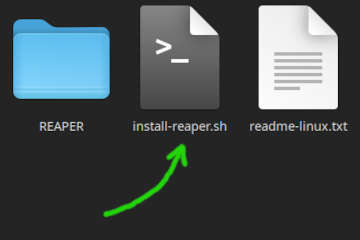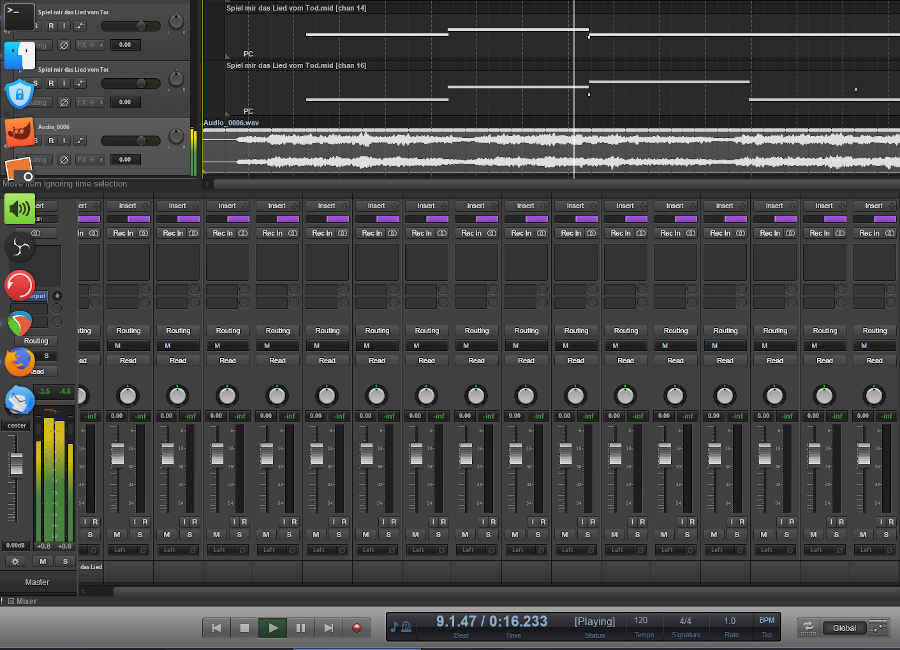I’ve searched hours for the best DAW which I could install on OpenSUSE Tumbleweed which has become my favorite Linux distribution. Since nothing suitable popped up, I went ahead and downloaded Reaper which I have used previously. Would OpenSUSE be able to run / install Reaper?
How to install Reaper in OpenSUSE Tumbleweed
Well, some things in life are hard and others are too easy. Installing Reaper in OpenSUSE Tumbleweed couldn’t be easier. All I had to do is download the Linux x86_64.tar.xz file, extract it in my Downloads directory and do a test run.

Doing a Reaper test run before installing
I didn’t know that I could just run Reaper from within the extracted tar file. Because of all the requirements that Reaper is listing, I didn’t think that Reaper would actually run. Imagine my surprise when I saw the spinning logo and a soon after, the actual DAW in all its glory.
I didn’t try anything and closed the software because curiosity took over and I had to try installing it. To actually install Reaper in OpenSUSE Tumbleweed, I just opened the terminal in the directory which I just extracted and issued this command:
./install-reaper.sh
Note that I didn’t prefix the command with sudo as there is no need to do so.
Reaper install options
As soon as I executed the install script, I was presented with four option. I chose the second one (I) which triggered the installation. I also opted to install Reaper in my /home directory because I’ve configured and set aside one computer just for audio recording. By configured I mean that I’ve connected an audio interface and setup proper monitoring etc.
The install only took a few seconds and as soon as it was done, I opened the menu and typed the letters Re which immediately triggered Reaper as the top choice (XFCE).
Just as I had experience earlier, the spinning logo appeared quickly and in a matter of seconds, Reaper opened up asked me to specify an audio device.
Steinberg UR22 MKII
I have two audio interfaces. One is reserved for my Yamaha Genos and the other for which ever computer I am working on. Here are my Options > Preferences > Audio > Device settings:
ALSA
Input channels: 2 Input device: hw: UR22mkii; USB-Audio – Steinberg UR22mkii
Output channels: 2 Output device: hw: UR22mkii; USB-Audio – Steinberg UR22mkii
Samplerate: 44100
Blocksize: 128
Bit depth: 32
Periods: 3
RT priority: 99 (maximum priority)
Checked “Auto-suspend PulseAudio” and left “Allow projects to override device sample rate” checked (default).
First audio recording with Reaper on OpenSUSE Tumbleweed
So far so good but will it actually all work? In German, we have a proverb that says “probieren geht ueber studieren” which means that trying is obove studying. And so I tried.
First, I connected one of my Audio Technica microphones, created a new track, armed it for recording and pressed the record button. After singing a few bars, I stopped and as soon as I heard that everything worked exactly as I hoped that it would, I was happy.

Conclusion
For some reason, many internet blogs and forum posts circle around free software that isn’t really up to the job when it comes to producing game audio tracks and advertising jingles. Reaper is an amazing DAW and if I wasn’t able to install it in OpenSUSE Tumbleweed, I would have to keep ArcoLinux one one machine because it works flawlessly on that distro.
Last but not least, a word about Reaper themes. By default, the Reaper 6 theme is a bit simple. I am not sure why but I need the visuals to kick into creative mode and therefore, I always grab a few themes from the reaper website. There are tons to chose from but all of the 5-star ones are worth checking out. Installing a Reaper theme is easy. Just drag the downloaded theme zip file onto Reaper and it will instantly apply itself.
Reaper is one of the most amazing digital audio workstations and although the Steinberg audio interface came with a free version for Cubase, I still prefer Reaper any day. If you are into audio production and prefer the Linux operating system then Reaper will be your DAW of choice.
Reaper works on all major operating systems and has a generous free trial period which doesn’t expire but the developer asks for a modest US $60 fee for home users which is more than fair.
Most DAWs charge more for an upgrade than Reaper costs.
Thank you for reading. I hope that knowing more about OpenSUSE and Reaper will be helpful to some of you. I am not planing on switching anytime soon so if you read this article sometime in the future and have questions about Reaper then feel free to leave a comment below.



Hey Ernst, thank you for this article! I just wanted to ask if you use a real time kernel for audio, and if you do, which one and how did you go about setting it up?
Kind regards,
Pavle 🙂
Hello Pavle,
I just use the stock kernel and it keeps up nicely with my audio interfaces. But in the past, a real-time kernel was necessary for low latency audio. Linux has come a long way.